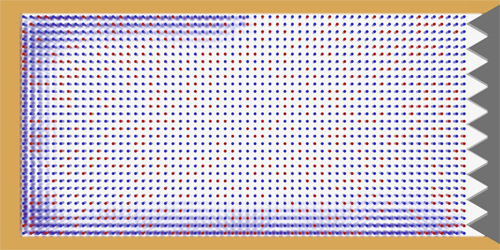Recipe for a One-Way Waveguide
Photonic alloys, which combine two or more photonic crystals, have great potential as waveguides, since the frequency of light that they transmit can be tuned by manipulating their crystal structure. However, photonic alloys usually suffer from light backscattering, which hinders information and energy transmission. Now Tiantao Qu from Shanxi University, China, and collaborators have fabricated a photonic alloy with a topological edge state that supports backscattering-free microwave propagation [1]. Remarkably, the researchers say, the alloy acquires its topological edge state when a single, nontopological photonic crystal has just a small, random fraction of its components replaced. The finding could lead to more efficient ways of fabricating topological photonic crystals.
The team started with an array of 600 millimeter-sized, nonmagnetic yttrium iron garnet rods arranged in a square lattice. Previous studies established that a system of only nonmagnetic rods is not topological, while one with only magnetic ones is. Using a source and a probe antenna to measure the intensity and phase of the microwaves propagating in the alloy, the team found that randomly replacing 20% of the nonmagnetic rods with magnetic ones sufficed to induce the edge state. Numerical simulations suggest that the larger the photonic-alloy lattice, the smaller the percentage of magnetic rods needed to achieve the topological edge state. For example, a square array of 10,000 rods would achieve the topological edge state if only about 2% of them were magnetic.
The researchers are now considering designs with additional edge states, which would increase the number of channels available for information and energy transport, possibly improving transport efficiency. They say that extending their work to the optical regime could lead to innovative photonic devices with unidirectional signal propagation and energy transport.
–Martin Rodriguez-Vega
Martin Rodriguez-Vega is an Associate Editor for Physical Review Letters.
References
- T. Qu et al., “Topological photonic alloy,” Phys. Rev. Lett. 132, 223802 (2024).




